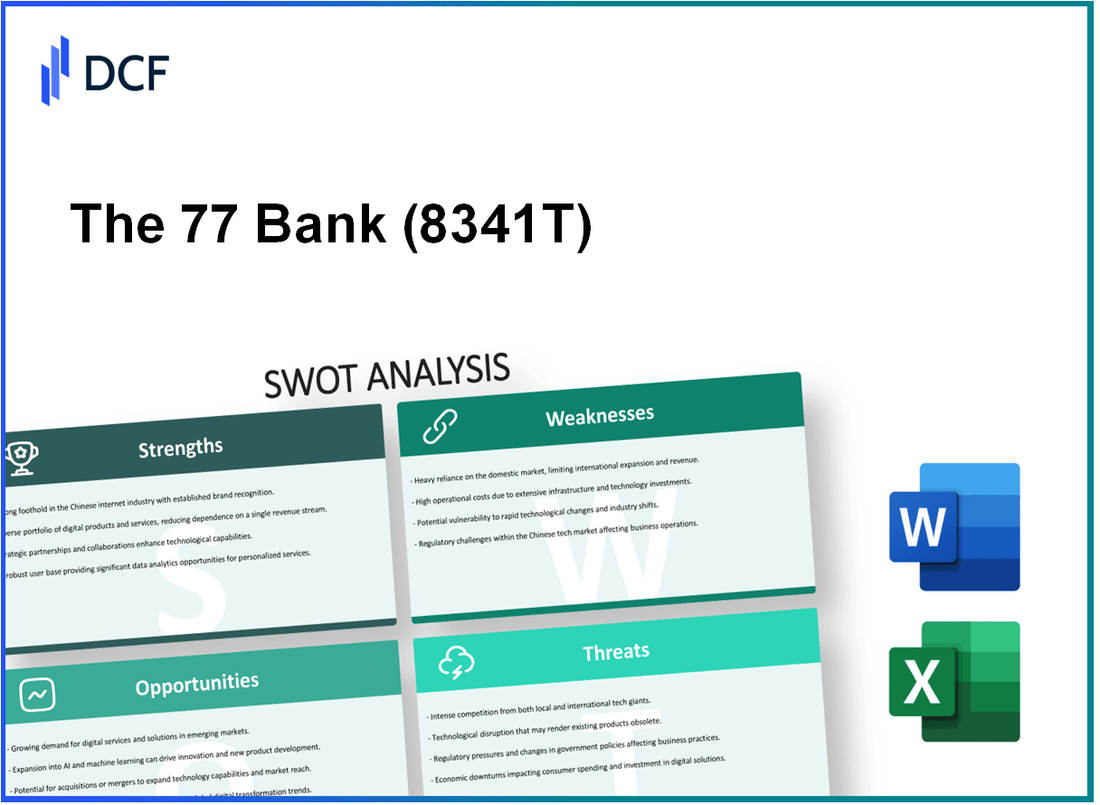
|
The 77 Bank, Ltd. (8341.T): SWOT Analysis |

Fully Editable: Tailor To Your Needs In Excel Or Sheets
Professional Design: Trusted, Industry-Standard Templates
Investor-Approved Valuation Models
MAC/PC Compatible, Fully Unlocked
No Expertise Is Needed; Easy To Follow
The 77 Bank, Ltd. (8341.T) Bundle
Discover how The 77 Bank, Ltd., a prominent financial institution in Japan, navigates the complexities of its market landscape through a comprehensive SWOT analysis. With strengths rooted in its established brand and operational resilience, coupled with weaknesses that highlight areas for improvement, this examination unveils exciting opportunities and looming threats that could shape its future. Dive in to uncover the strategic insights guiding this regional powerhouse!
The 77 Bank, Ltd. - SWOT Analysis: Strengths
The 77 Bank, Ltd. has established itself as a prominent financial institution primarily serving the Miyagi Prefecture in Japan. Its long-standing history and deep regional connections give it an edge in a competitive market.
One of the primary strengths of The 77 Bank is its established brand with a strong regional presence. With over 150 years of operation, the bank has cultivated a reputation for reliability and trust within the community. It operates more than 120 branches across Miyagi Prefecture, solidifying its local influence and customer loyalty.
The bank offers a diverse range of financial services, which cater to both retail and corporate clients. As of fiscal year 2022, approximately 40% of the bank’s income was derived from its retail banking services, including personal loans, savings accounts, and credit cards. Corporate banking services account for another 35% of revenue, providing loans, treasury services, and asset management solutions to local businesses.
In terms of financial stability, The 77 Bank boasts a strong capital base with a solid asset portfolio. For the year ending March 2023, The 77 Bank reported total assets of approximately ¥3.5 trillion (around $26 billion). The bank maintains a capital adequacy ratio of 8.43%, exceeding the regulatory minimum set by the Financial Services Agency of Japan, which is 4%.
| Financial Metrics | Value |
|---|---|
| Total Assets (March 2023) | ¥3.5 trillion |
| Capital Adequacy Ratio | 8.43% |
| Retail Banking Revenue (2022) | 40% |
| Corporate Banking Revenue (2022) | 35% |
| Number of Branches | 120+ |
Moreover, The 77 Bank enjoys high customer trust and fosters long-term relationships with local businesses. Recent customer satisfaction surveys indicate that over 85% of clients express confidence in the bank’s ability to meet their financial needs. This trust is further reflected in the bank’s retention rates, which hover around 90%, indicating strong customer loyalty and satisfaction.
In conclusion, the bank's established brand, diverse financial services, solid capital base, and high customer trust position it favorably within the competitive landscape of financial services in Japan.
The 77 Bank, Ltd. - SWOT Analysis: Weaknesses
The 77 Bank, Ltd. exhibits several weaknesses that can hinder its growth and competitiveness in the banking industry. Understanding these areas is crucial for stakeholders and investors.
Over-reliance on the local market, limiting geographic diversification
The 77 Bank has a substantial focus on its domestic market, with approximately 90% of its total assets held within Japan as of fiscal year 2022. This over-reliance constrains the bank's ability to capitalize on growth opportunities in foreign markets.
Traditional banking methods may lag behind digital transformation trends
Despite the rise of digital banking, The 77 Bank has maintained a conservative approach in its adoption of technology. In 2022, the bank reported that only 25% of its transactions were processed digitally, compared to the industry average of 45%. This slow adaptation could lead to loss of customer base to more agile, tech-savvy competitors.
Limited presence outside of domestic markets affects international growth potential
The 77 Bank's international branches are limited, with only 5 branches outside Japan, primarily located in the United States and China. This is a stark contrast to competitors like Mitsubishi UFJ Financial Group, which has over 500 branches worldwide. As a result, The 77 Bank lacks the vast network necessary to facilitate cross-border banking relationships effectively.
Interest rate fluctuations in Japan could impact profitability margins
The Bank of Japan's interest rate policy has remained at record lows, with the current rate around -0.1%. This environment squeezes net interest margins, with The 77 Bank reporting a net interest margin of 0.95% in 2022. Should rates rise, it could impact borrowing costs and demand for loans, creating further uncertainty in profitability.
| Weakness | Details | Impact |
|---|---|---|
| Over-reliance on local market | Approximately 90% of total assets in Japan | Limits growth and diversification |
| Lag in digital transformation | Only 25% of transactions digital | Risk of losing customers to competitors |
| Limited international presence | Only 5 branches outside Japan | Affects global competitiveness |
| Interest rate sensitivity | Current rate at -0.1%, net interest margin of 0.95% | Profit margins at risk |
These weaknesses highlight critical areas for The 77 Bank, Ltd. as it navigates the complexities of the modern banking environment. Addressing these issues will be vital to its long-term sustainability and growth prospects.
The 77 Bank, Ltd. - SWOT Analysis: Opportunities
The expansion of digital banking services presents a significant opportunity for The 77 Bank, Ltd. As of the fiscal year 2023, the digital banking market in Japan is projected to grow at a compound annual growth rate (CAGR) of 17.4% from 2023 to 2028, reaching an estimated market size of ¥2.4 trillion (approximately $22 billion) by 2028. This growth is fueled by increasing smartphone penetration and a heightened demand for online banking services among tech-savvy consumers.
Strategic partnerships with fintech companies can enhance The 77 Bank's service offerings. The Japanese fintech market is expected to reach ¥2.5 trillion (approximately $23 billion) by 2025, representing a CAGR of 23.1%. Collaborating with innovative financial technology firms can help streamline operations, reduce transaction costs, and augment the bank's existing digital capabilities.
There is a compelling potential for growth in sustainable financing and green investment products. The Japanese government has committed to achieving net-zero greenhouse gas emissions by 2050 and aims to boost green finance initiatives. As of 2023, the market for green bonds in Japan has exceeded ¥1.5 trillion (approximately $14 billion), indicating a growing trend in environmentally conscious investment opportunities that The 77 Bank can tap into.
Additionally, serving the aging population with specialized financial products represents another avenue for growth. Japan's population aged 65 and older is projected to reach 38% by 2040, presenting challenges and opportunities in the financial sector. The development of tailored retirement planning services and products can cater to this demographic's unique needs, which is estimated to generate an additional ¥800 billion (around $7.5 billion) in revenue by 2025.
| Opportunity | Market Size (2023) | Projected Growth (CAGR) | Potential Revenue (by 2025) |
|---|---|---|---|
| Digital Banking Services | ¥2.4 trillion ($22 billion) | 17.4% | N/A |
| Fintech Partnerships | ¥2.5 trillion ($23 billion) | 23.1% | N/A |
| Sustainable Financing | ¥1.5 trillion ($14 billion) | N/A | ¥800 billion ($7.5 billion) |
| Aging Population Financial Products | N/A | N/A | ¥800 billion ($7.5 billion) |
The 77 Bank, Ltd. - SWOT Analysis: Threats
Intense competition from other regional and national banks is a significant threat to The 77 Bank, Ltd. In Japan, the banking sector has seen a rise in competition, with over 100 regional banks vying for market share. As of December 2022, regional banks like Resona Holdings and Fukuoka Financial Group reported year-over-year net income increases of 11.2% and 3.5%, respectively. This competitive environment puts pressure on The 77 Bank’s interest margins and customer retention efforts.
Economic instability in Japan has emerged as another serious threat. The Bank of Japan's monetary policy has resulted in a prolonged period of low interest rates, which affects profitability. In the first half of 2023, GDP growth was only 0.6%, and analysts predict potential stagnation. This can lead to increased defaults on loans, affecting The 77 Bank's asset quality. As of the second quarter of 2023, the bank’s non-performing loans ratio stood at 1.1%, a level that may rise if economic conditions worsen.
Regulatory changes in the banking sector may increase operational costs for The 77 Bank. The Financial Services Agency (FSA) in Japan has enacted stricter compliance measures that require banks to increase their capital buffer. As of 2023, capital adequacy ratios must be raised to 8% for domestic banks. This has implications for liquidity management and overall profitability, as banks must allocate more funds to meet regulatory requirements. In a recent report, operational costs across the banking sector rose by an average of 6% due to compliance measures.
Cybersecurity threats and data breaches pose significant risks to digital banking operations. In 2022, the financial services sector experienced a 30% increase in cyberattacks according to the Cybersecurity and Infrastructure Security Agency (CISA). The 77 Bank relies heavily on its digital platforms, where around 70% of its transactions occur. A significant breach could lead to considerable financial losses, reputational damage, and regulatory fines. In 2023, it was estimated that the average cost of a data breach in the financial sector reached $5.97 million, a number that could severely impact The 77 Bank’s financial standing.
| Threat Category | Details | Impact Estimation |
|---|---|---|
| Intense Competition | Over 100 regional banks competing for market share. | Pressure on interest margins and customer retention. |
| Economic Instability | GDP growth at 0.6%, non-performing loans ratio at 1.1%. | Potential increase in defaults affecting asset quality. |
| Regulatory Changes | Capital adequacy ratios raised to 8%. | Increased operational costs by 6% due to compliance. |
| Cybersecurity Threats | 30% rise in cyberattacks in financial services. | Average cost of data breach at $5.97 million. |
In the dynamic landscape of the financial sector, The 77 Bank, Ltd. stands at a critical juncture, poised to leverage its strengths while addressing significant weaknesses. By seizing opportunities in digital banking and sustainable finance, and navigating external threats, the bank can not only reinforce its competitive stance but also contribute meaningfully to its regional economy.
Disclaimer
All information, articles, and product details provided on this website are for general informational and educational purposes only. We do not claim any ownership over, nor do we intend to infringe upon, any trademarks, copyrights, logos, brand names, or other intellectual property mentioned or depicted on this site. Such intellectual property remains the property of its respective owners, and any references here are made solely for identification or informational purposes, without implying any affiliation, endorsement, or partnership.
We make no representations or warranties, express or implied, regarding the accuracy, completeness, or suitability of any content or products presented. Nothing on this website should be construed as legal, tax, investment, financial, medical, or other professional advice. In addition, no part of this site—including articles or product references—constitutes a solicitation, recommendation, endorsement, advertisement, or offer to buy or sell any securities, franchises, or other financial instruments, particularly in jurisdictions where such activity would be unlawful.
All content is of a general nature and may not address the specific circumstances of any individual or entity. It is not a substitute for professional advice or services. Any actions you take based on the information provided here are strictly at your own risk. You accept full responsibility for any decisions or outcomes arising from your use of this website and agree to release us from any liability in connection with your use of, or reliance upon, the content or products found herein.
